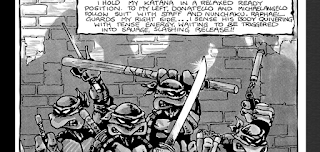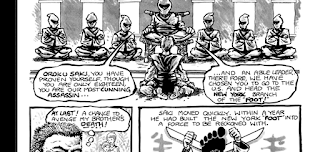Teenage Mutant Ninja Turtles #1-7 + Raphael
Originally released in 1984
Written by Kevin Eastman and Peter Laird
Art by Kevin Eastman and Peter Laird
Humble Bundle had a deal on Teenage Mutant Ninja Turtles comics, including a variety of runs through the decades, so I decided to get that bundle. For those who aren't familiar, the Teenage Mutant Ninja Turtles are four mutated turtles who were raised by a mutated rat named Splinter. Splinter taught them to be ninja teens. Leonardo leads; Donatello does machines. Raphael is cool but rude; Michelangelo is a party dude.
In case that didn't make it obvious enough, the bulk of my Ninja Turtle knowledge comes from the 80s/90s cartoon. Tonally, this original run is pretty far removed from that. (The bloody sword on the cover is enough evidence of that) It starts off as a story about the cycle of revenge - Hamato Yoshi caught Oroku Nagi attacking Yoshi's wife, so in a rage, Yoshi killed Nagi. Yoshi and his wife fled to America, and Oroku Saki, Nagi's younger brother, trained for years to avenge him.
Saki (now working for the Foot Clan) killed Yoshi and his wife, but Yoshi's intelligent pet rat escaped and was living in the sewers when a mysterious radioactive ooze and four turtles fell into it. As a side note, the origin also hints that it's the same accident that created Daredevil - why haven't we gotten a TMNT crossover with Daredevil, Spider-Man, or the Fantastic Four yet?
Splinter learned ninjutsu through watching Hamato Yoshi practice, and he taught it to the turtles when the five of them mutated and gained humanoid features and intelligence. Now, fifteen years later, Splinter wants the turtles to avenge his owner/master and murder Oroku Saki, who is also known as the Shredder.
Shredder is the most enduring villain the Ninja Turtles have faced; if the Ninja Turtles appear in anything, then it seems like the Shredder will either be the main villain or teased for the sequel. Of course, as the villain, he's not about to fight in a fair or honourable way (though arguably, the Ninja Turtles fighting him four-on-one isn't honourable either); he sends the Foot Clan after them.
Once the faceless ninjas are beaten, it's time for the main event. Shredder outclasses the turtles individually, but by keeping their distance and working as a team, they manage to whittle him down. Still, I figured he was going to escape, badly injured but with the Turtles too weak to stop him, serving as a key member of their rogues' gallery as the Ninja Turtles got into crazy adventures each month.
That's... not how it turned out, to say the least. There's some ambiguity in the issue itself, but looking into it, it turned out that Shredder canonically died here, with future appearances being a clone or a colony of worms that took his form. It feels weird to me - like if the Kingpin appeared in Daredevil's first issue only to be killed off by the end of it. (Then again, Eastman and Laird had no way of knowing how big this creation of theirs would get)
Issue 2 introduces long-running foes Baxter Stockman (I'm not sure if him becoming a human fly was just in the 80's cartoon) and his pest control robots the Mousers. This issue also establishes more about the individual personalities of the Turtles, such as Donatello tinkering with machines and Leonardo being the responsible one who is concerned for Splinter. The first issue established that Raphael enjoyed fighting more than the others, but for the most part, it was an action-heavy romp that also explained the Turtles' backstory.
Issue 2 also introduces long-running TMNT supporting character April O'Neil, though despite Baxter being interviewed on TV, she's not the reporter giving the interview. Rather, she's Baxter's lab assistant who helped to program the Mousers.
A string of bank robberies are carried out by what could only be the Mousers; it turns out that Baxter used the money to build an army of Mousers, and he is planning to hold the city hostage by demolishing various corporate headquarters if they don't send him money. April points out that he could have just earned the money legitimately (the Mousers revolutionized pest control), but Baxter is doing this because it's fun.
Once Baxter drops April in the sewers and sends Mousers after her, the Turtles save her and put a stop to Stockman's schemes. The Mousers are a threat to the Turtles between their mechanical nature, ability to eat nearly anything, and their sheer numbers, but April and Donatello manage to activate an emergency shutdown program just in the nick of time.
The Turtles return home to find Splinter missing and damaged Mousers everywhere. With police and work crews combing the sewers in the aftermath of Baxter's threats, the Turtles are forced to flee to the surface, where April picks them up in a van. One thing leads to another, and soon, they're being chased by the police through Central Park after April's van is mistaken for one that was used in a robbery.
An epilogue reveals what happened to Splinter - he managed to fend off the Mousers long enough for Baxter's self-destruct program to activate and send them back to his lab, but he passed out from pain and blood loss. He was found and treated by a group of scientists from a group called TCRI (the same one that created the ooze that turned Splinter and the Turtles into mutants), only to discover the truth about the group's employees as he's trying to sneak out.
They're all Krangs! But first, the collection moves on to what's described as #1 in a one issue micro-series called "Raphael: Teenage Mutant Ninja Turtle". Even this early on, Raphael has some serious anger issues, and he's sent outside to cool off after being overcome with bloodlust during a spar. Raphael's disappointed in himself after that, having no idea why he gets that way.
While trying to clear his head, Raph meets vigilante Casey Jones, who watched Dirty Harry and Death Wish movies too many times and decided to bring peace to New York City's streets with hockey gear and deadly violence. Raph can't stand by and let him kill people, so he intervenes.
It's impressive how much world-building is done this early on. In three issues and a spin-off, the series has established basically every character that would turn out to be a major part of the franchise (aside from Rocksteady and Bebop) while covering four wildly different types of antagonists (independent vigilantes like Casey, ancient organizations with Shredder and the Foot Clan, futuristic technology with Baxter Stockman, and alien conspiracies with TCRI) and making all of these wildly different characters and groups feel like they naturally fit in this setting.
An attack by the Foot Clan leads to the Turtles finding the TCRI building, and recognizing that name from the cannister that created them, they decide to investigate. However, they're living in April's apartment and don't think to close the blinds, so someone across the street sees the Ninja Turtles living there - either the person across the street was keeping an eye out for the Turtles, or the telescope that they had which was pointed at April's apartment was being used for more unsavoury purposes, but either way, it doesn't bode well.
The Turtles infiltrate the TCRI building to find Splinter frozen in some sort of suspended animation, only to be attacked by robots that are being piloted by brain-like aliens. While trying to escape, they activate a teleporter and wind up in outer space!
Befriending a scientist whose consciousness was put into a robot body by a freak accident, the Turtles travel to a grimy bar to try and find a ship that will take them off-world and back to Earth. The bar in question takes so much inspiration from Star Wars that I was surprised that they didn't squeeze in a cameo of characters who looked a lot like Obi-Wan, Han Solo, Luke, Chewbacca, or even Greedo. (Though going by the interviews with the original creators that are included in this collection after the individual issues, they went as far as they thought they could get away with)
The interviews shed light on their other inspirations as well, such as Jack Kirby and Frank Miller. (Jack Kirby gets mentioned as inspiring their panelling layouts a lot) The robot, known as Professor Honeycutt or the Fugitoid, is kidnapped by bipedal alien triceratopses who want the robot's knowledge all for themselves. (The scientist had been trying to build his own teleporter, though he hasn't got a working one yet)
To force the professor to cooperate, the Turtles are taken prisoner and forced into gladiatorial games. It doesn't work out like the Triceratons hoped it would, as they beat their opponents and rescue the professor.
Just when it seems like they're cornered with no way out, the Turtles, the professor, and two Triceratons are teleported back to Earth. Once the Triceratons are defeated, the Krang-like aliens clear things up: they weren't a malevolent invasion, and they just wanted to leave Earth. The arrival of Splinter, alive and well, convinces the Turtles of the Krang-like aliens' truthfulness.
When the Turtles had teleported previously, it caused a massive beam of light to shoot from the roof of TCRI, and with no explanation of what it was (and no way to contact the company - it doesn't exist in any official capacity), the army is forced to break into it. The aliens are forced to evacuate via teleporter before activating the self destruct, and the Turtles and Splinter are teleported home as well. ...sort of.
By the time I was finished, I could hardly believe that I had read over three hundred pages. The time just flew by; I was worried, based on the first issue, that these early comics would be darker and edgier compared to what I was used to from the TMNT franchise, but later issues were filled with this sense of whimsy; you could really tell that Eastman and Laird were experimenting with whatever ideas they were interested in, and the popularity of the series allowed them to keep going with doing whatever they wanted. In a lot of ways, it reminds me of Stan Lee and Jack Kirby's Fantastic Four run. I thought it might take a while for the team to find their footing, but Teenage Mutant Ninja Turtles had me hooked from the very start.




























No comments:
Post a Comment